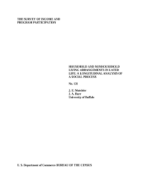
An official website of the United States government
Here’s how you know
Official websites use .gov
A .gov website belongs to an official government organization in the United States.
Secure .gov websites use HTTPS
A lock (
) or https:// means you’ve safely connected to the .gov website. Share sensitive information only on official, secure websites.
-
//
- Census.gov /
- Library /
- Census Working Papers /
- Household and Nonhousehold Living Arrangements in Later Life
Household and Nonhousehold Living Arrangements in Later Life: A Longitudinal Analysis of a Social Process
Household and Nonhousehold Living Arrangements in Later Life: A Longitudinal Analysis of a Social Process
Considerable discussion in recent years has focused on the living arrangements of the elderly population in the United States. Among the trends most noted by demographers, as well as by policymakers, are the rising rates of living alone in later life. Over half of all unmarried individuals live alone in their later years, suggesting that current cohorts are retaining a high level of independence as they age. Although a much smaller share of this population is unable to maintain community residence much less live alone; as much as 25 percent of the elderly population will be institutionalized some time during their lives (Manton, Woodbury and Liu, 1984; Palmore, 1976). The distribution of individuals across these different types of living arrangements--from living alone to institutionalization, to living with others within the community-are reflective of the demographic, socioeconomic, and health characteristics of those in the older age groups, as well as their preferences for various living arrangements.
Those who have studied the patterning of living arrangements in later life agree that socioeconomic resources are important concerns when individuals are deciding with whom they will live. In short, individuals are poorly equipped to act on their living arrangement preferences in the absence of sufficient resources. Increases in economic resources among the elderly population over the last several decades, facilitated by near-universal coverage by Social Security and the shift of public resources toward the older segments of the population (Bane, Wilson and Baer, 1983; Preston, 1984; Weicher, 1989), likely enhance the ability to act on these preferences. Further, some analysts argue that institutional options are often closed to those who can neither afford the expense of long-term care nor wish to "spenddown" their resources in order to benefit from public funding for care. Thus, both institutional and noninstitutional living arrangements are conditioned to some degree by economic resources in later life.
Because choice of living arrangement may be associated with different costs (Michael, Fuchs, and Scott, 1980) and different access to public and private resources (Schwartz, Danziger, and Smolensky, 1984), a fuller understanding of the relationship between economic resources and living arrangements is an ongoing public policy concern (Soldo, 1981). Yet up to now, knowledge of these empirical relationships has been limited because most studies rely on crosssectional data measuring living arrangements and individual characteristics and resources concurrently. For example, if living arrangement choices are thought to be in part a response to economic resources, then the analysis of living arrangement choice is weakened by cross-sectional measurement. A more accurate assessment of the effect of economic resources on living arrangements in later life would measure resources at some time prior to a change in living arrangements. The present paper offers such an assessment.
Others in Series
Working Paper
Working Paper
Working Paper
Share
Related Information
Some content on this site is available in several different electronic formats. Some of the files may require a plug-in or additional software to view.
 Yes
Yes
 No
NoComments or suggestions?


Top

